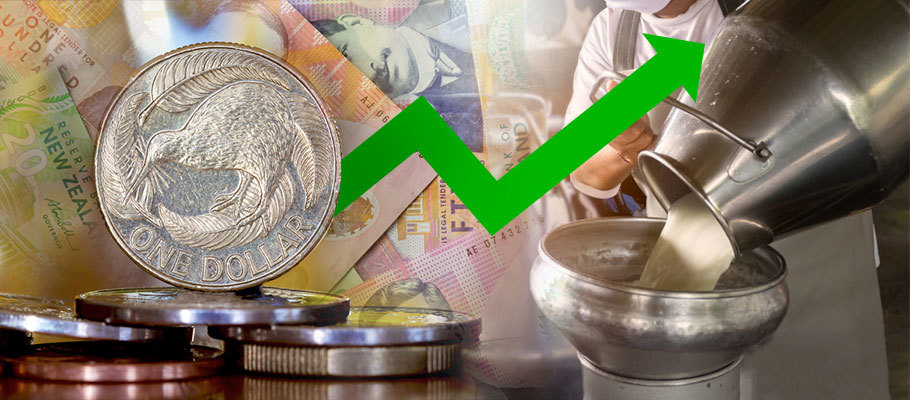
Published: February 9th, 2022
New Zealand lender ASB has raised its forecasts for New Zealand dairy prices, meaning the antipodean nation should see its commodity exports rise over the coming months, alleviating some of the uncertainty brought on inflation and the COVID Omicron variant.
'Given sub-optimal growing conditions and the failure of overseas producers to step in and displace NZ farmers, we believe the current market view is correct,' said ASB's economics unit in an investor note. 'Supply is likely to stay tight beyond the end of the season.
Fonterra's Global Dairy Trade price index for New Zealand suggests milk prices have reached their highest levels since March 2013, giving a considerable fillip to New Zealand's export earnings prospects.
ASB believes tight supply will persist into the 2022/2023 growing season, pushing next season's milk price forecast to a healthy USD 8.90 per kgMS.
Dairy products are New Zealand’s biggest export category, bringing in around USD 12.6 BN annually. Dairy accounts for one in every three dollars the country earns from exports. Rising dairy prices will almost certainly lift New Zealand's trade dynamics, giving the kiwi (NZD) a fundamental source of support.
In a market commentary, the International Economics Unit at Commonwealth Bank of Australia said the rise in dairy prices also supported its NZD/USD forecast of 0.75 by year-end 2022.'
At the time of writing, the NZD/USD exchange rate is 0.66, while GBP/NZD sits at 2.0320.
Until February 2020, New Zealand exported USD 13.8 BN in dairy products, injecting NZD 7.5 BN directly into the New Zealand economy.
Fonterra's price index says New Zealand dairy prices have reached a seven-year high as of January 31st, amid extended strong demand and reduced dairy production globally.
Fonterra is the island nation's largest dairy company, a co-operative owned by New Zealand dairy farmers that handles more than 90 per cent of all milk production. Its January auction beat analyst estimates by more than four per cent.
‘It looks as though New Zealand farmers will begin next season on the front foot,’ said ASB in its investor note. 'Since near-term dairy supply is set to be down globally, demand for New Zealand dairy is still looking strong.’
Despite supportive export dynamics, NZD has been trending lower against the US dollar since July 2021 and lower against sterling since October 2021.
Those trends suggest the kiwi is still beholden to uncertain global market conditions, despite New Zealand’s strong export fundamentals.
The shaky start to 2022 exhibited by global equity markets has played a role in NZD’s price action this quarter.
At the same time, forex traders have priced in their expectations for a rate hike by the Reserve Bank of New Zealand (RBNZ), which is why the fiat isn't getting a lift from increasing speculation about the central bank getting ready to lead in the G10 race to tighten monetary policy.
Questions about how the economy will fare in the midst of the Omicron outbreak is also weighing on the NZD outlook.
Speaking to Bloomberg, senior Westpac Economist Sajiv Chodhury said that there is also uncertainty about how Omicron will impact the labour market. ‘We are still in the early stages of this variant spread, and it's too soon to say how negative the health outcomes might be.’
New Zealand Finance Minister Geoff Robinson has said that the government is operating under a scenario where close to 350,000 people are compelled to self-isolate, which would equate to about 13 per cent of the labour force.
'This year’s Omicron outbreak will almost certainly disrupt the labour market,’ said ASB's investor note. ‘Though its impacts are thought to be less severe, it strains a labour market that’s already stretched and aggravates wage inflation.’
‘Domestic cost pressures are also on the rise,’ said Westpac’s Chodhury. 'Many New Zealand businesses can’t find enough workers, and wage costs have been rising as competition for skilled staff increases’.
Regardless of domestic uncertainties, the likelihood of higher dairy prices and interest rates is set to deliver a supportive backstop to any NZD weakness in the coming months. Consensus is also growing for an extended New Zealand recovery into the second half of 2022.
New research from RBC Capital Markets pegs the kiwi to be amongst the biggest G10 winners in February 2022.
RBC’s currency strategy unit has studied the performance of currencies in January and February, going back more than a decade. It shows that some have an uncanny ability to flip their January performance, especially if price moves tend to the extreme.
In a summary accompanying the research, RBC’s analysts said that ‘NZD, AUD, and CAD have repeatedly overshot expectations in January, only to face a reversal the next month.
NZD was the biggest loser amongst these commodity currencies in January 2020, falling against all its peers. The BBP/NZD exchange rate rose 3.3 per cent, the EUR/NZD rate rose 2.59 per cent, and the NZD/USD rate fell by four per cent.
‘It is difficult to overstate just how poorly the kiwi performed in January 2020. Following a 3.6 per cent drop against USD, it was the worst G10 performer,’ said the research summary.
RBC analysts also found it difficult to explain why NZD traded so badly but said seasonality could be an explanation.
RBC found that some of the typical factors, including a combination of weaker stock prices and tighter rate spreads, explained only 0.5 per cent of the 3.6 per cent monthly fall.
'It's our belief that all three G10 commodity currencies have a strong tendency to exceed trends in both directions in January, then stage a reverse in the rest of the first quarter.
If the analysis is accurate, the New Zealand Dollar may be in for a February (or March) where it posts gains against the euro, greenback, and sterling.